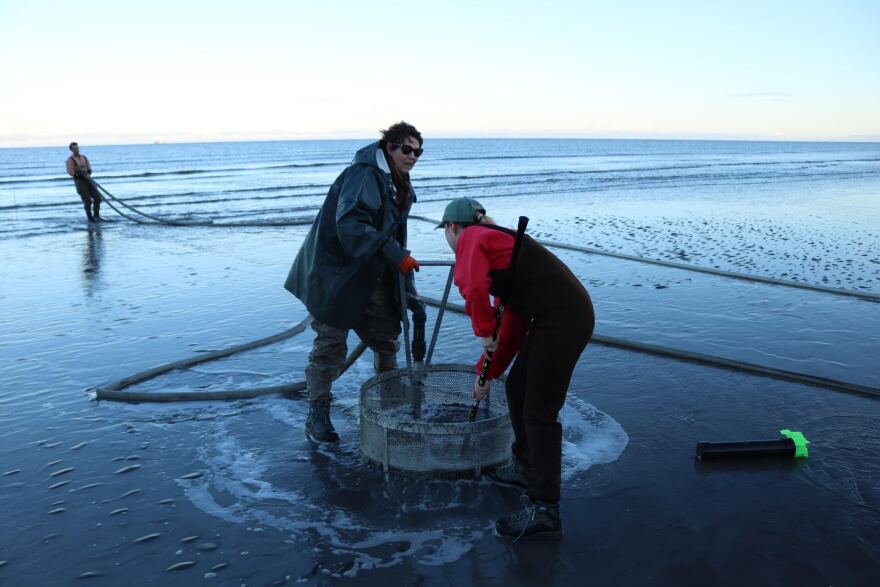Clam diggers from the Kenai River to the Homer Spit hoping for the return of razor clams were sorely disappointed this summer. This year was the third season in a row the Alaska Department of Fish and Game issued an emergency order closing popular razor clam fisheries, but there is a tiny glimmer of hope the tasty morsels are making a comeback.
Early on a September morning, volunteers and Fish and Game staff are racing against the tide as it goes out at Clam Gulch on the east side Cook Inlet. They’re surveying for razor clams, digging holes every 50 feet with a large water probe that resembles a pressure washer.
“We work this probe around this half-meter round circle, and I try to fully emulsify the substrate inside and that’s our sample area for this plot, we call these plots,” Carol Kerkvliet said, a sport fish area management biologist for Fish and Game.
After she blasts a hole into the beach, volunteers use old lacrosse sticks to scoop up any clams hiding in the liquified sand.
Kerkvliet’s coworker Mike Booz is a sport fish assistant area management biologist, and he reads off the measurements of every clam they find.
Fish and Game has been surveying beaches annually near Ninilchik and Clam Gulch since 2011. They found there are two big problems: fewer juvenile clams are showing up on those beaches, and the clams there are dying at incredibly high rates.

“Ninilchik beaches, we estimated the natural mortality on one of these juvenile age classes from 2016 to 2017 to be over 70 percent,” Booz explained. “It takes a very significant amount of new recruitment to the beach to be able to compensate for that high of level of natural mortality, for there to still end up being clams when they’re five or six years old.”
Fish and Game estimated there were about 1.7 million clams on Ninilchik beaches in 2011, but that number was cut in half the next year, and that pattern has held true up until now.
As the survey progress into the middle of the beach at Clam Gulch, the team is finding more clams.
Both Kerkvliet and Booz say anecdotally the number of clams they’re seeing isn’t high, but what they are seeing is a good number of juvenile clams and one-year-olds smaller than your pinky nail.
“Yea, it’s a good sign that we’re continuing to get new recruitment to these beaches. The number of adult clams that are on this beach is still really low,” Booz said. “Basically, we need these to grow to their adult size before we have adult clams here again.”
If those younger razor clams make it to about five years old, clam diggers may get to see the fishery reopen in the near future, something Kerkvliet thinks could happen.
On the other side of things, Fish and Game still doesn’t know why clams are dying at high rates or why recruitment of juvenile clams took a big hit in recent years. Booz notes these surveys aren’t really aimed at answering those questions.
“We can ensure that their habitat is good and that there’s not impacts from us and that the harvest rates on this beach are at sustainable rates,” Booz said. “Currently even with the fishery closed, we’re still experiencing really high rates of natural mortality.”
Booz explains there is likely no single answer to why razor clams are struggling, and adds there could be a number of environmental factors, something outside of Fish and Game’s control.
But, if the young clams survive through the winter and continue to grow into next fall, that could be a sign that the tide is turning.



